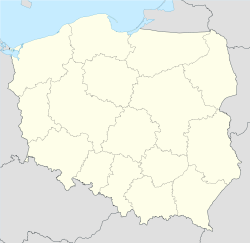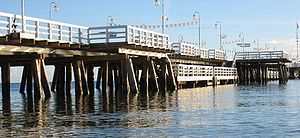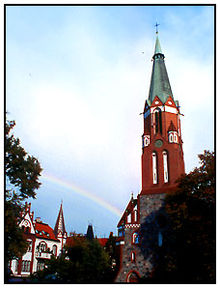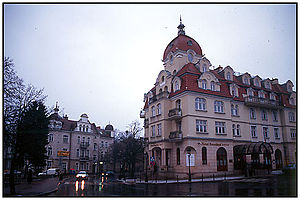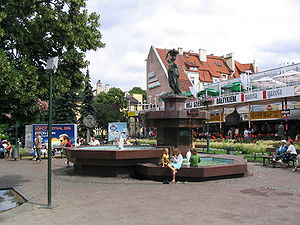- Sopot
-
This article is about the city Sopot in Poland. For other places with the same name, see Sopot (disambiguation).
Sopot Grand Hotel, one of the city's landmarks 
Flag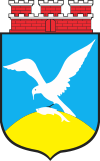
Coat of armsMotto: Najmniejsze z wielkich miast
(Smallest of the big cities)Coordinates: 54°26′N 18°33′E / 54.433°N 18.55°E Country  Poland
PolandVoivodeship Pomeranian County city county Established 8th century Town rights 1901 Government – Mayor Jacek Karnowski Area – City 17.31 km2 (6.7 sq mi) Population (2008) – City 38,821 – Density 2,242.7/km2 (5,808.5/sq mi) – Metro 1,035,000 (Tricity) Time zone CET (UTC+1) – Summer (DST) CEST (UTC+2) Postal code 81-701 to 81-878 Area code(s) +48 58 Car plates GSP Website www.sopot.pl Sopot [ˈsɔpɔt] (
 listen) (German: Zoppot (
listen) (German: Zoppot ( listen); Kashubian: Sopòt) is a seaside town in Eastern Pomerania on the southern coast of the Baltic Sea in northern Poland, with a population of approximately 40,000.
listen); Kashubian: Sopòt) is a seaside town in Eastern Pomerania on the southern coast of the Baltic Sea in northern Poland, with a population of approximately 40,000.Sopot is a city with powiat (county) status, in Pomeranian Voivodeship. Until 1999 it was in Gdańsk Voivodeship. It lies between the larger cities of Gdańsk (to the south-east) and Gdynia (to the north), the three towns together making up the metropolitan agglomeration called Trójmiasto (Tri-City).
Sopot is a major health-spa and tourist resort destination. It has the longest wooden pier in Europe, at 515.5 metres, stretching out into the Bay of Gdańsk. The city is also famous for its Sopot International Song Festival, the largest such event in Europe after the Eurovision Song Contest. Among its other attractions is a fountain of bromide spring water, known as the "inhalation mushroom".
Contents
Etymology
The name is thought to derive from an old Slavic word sopot meaning "stream"[1] or "spring".[2] The same root occurs in a number of other Slavic toponyms; it is probably onomatopeic, imitating the sound of running water. (Today several streams run into the sea in the area of the town.)
The name is first recorded as Sopoth in 1283 and Sopot in 1291. The German Zoppot is a Germanization of the original Slavic name. In the 19th century and in the interwar years the German name was Polonized as Sopoty (a plural form) or Copoty (another plural form, closer to the German pronunciation).[1] "Sopot" was made the official Polish name when the town came again under Polish rule in 1945.
History
Early history
The area of today's Sopot contains the site of a 7th-century Slavonic (Pomeranian) stronghold. Initially it was a commercial trade outpost for commerce extending both up the Vistula river and to cities north across the Baltic Sea. With time the significance of the stronghold diminished and by the 10th century it was reduced to a fishing village, eventually abandoned. However, a century later the area was settled again and two villages were founded within the borders of today's' city: Stawowie and Gręzowo. They were first mentioned in 1186 as being granted to the Cistercian abbey in Oliwa. Another of the villages that constitute today's Sopot, Świemirowo, was first mentioned in 1212 in a document by Mestwin I, who granted it to the Premonstratensian (Norbertine) monastery in nearby Żukowo.
The village of Sopot, which later became the namesake for the whole city, was first mentioned in 1283 when it was granted to the Cistercians. By 1316 the abbey had bought all villages in the area and became the owners of all the area of the city. After the Second Peace of Thorn (1466) the area was reincorporated into the Kingdom of Poland.
The spa for the citizens of Gdańsk has been active since the 16th century. Until the end of that century most noble and magnate families from Gdańsk built their manor housees in Sopot. During the negotiations of the Treaty of Oliva King John II Casimir lived in one of them, while Swedish negotiator Magnus de la Gardie resided in another — it has been known as the Swedish Manor ever since.
During the 1733 War of the Polish Succession Imperial Russian troops besieged the nearby city of Gdańsk and a year later looted and burned the village of Sopot to the ground. Much of Sopot would remain abandoned during and after the conflict.
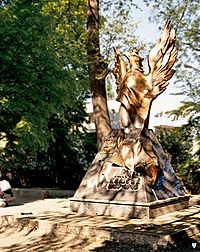 Monument to the Armia Krajowa
Monument to the Armia Krajowa Memorial Stone for Danuta Siedzikówna in Sopot
Memorial Stone for Danuta Siedzikówna in Sopot
In 1757 and 1758 most of the ruined manors were bought by the Pomeranian magnate family of Przebendowski. General Józef Przebendowski bought nine of these palaces and in 1786 his widow, Bernardyna Przebendowska (née von Kleist), bought the remaining two.
Kingdom of Prussia
Sopot was annexed by the Kingdom of Prussia in 1772 in the First Partition of Poland. Following the new laws imposed by King Frederick the Great, church property was confiscated by the state. The village was reconstructed and in 1806 the area was sold to the Gdańsk merchant Carl Christoph Wegner.
In 1819 Wegner opened the first public bath in Sopot and tried to promote the newly-established spa among the inhabitants of Danzig, but the undertaking was a financial failure. However, in 1823 Dr. Jean Georg Haffner, a former medic of the French army, financed a new bath complex that gained significant popularity. In the following years Haffner erected more facilities. By 1824 a sanatorium was opened to the public, as well as a 63-metre pier, cloakrooms, and a park. Haffner died in 1830, but his enterprise was continued by his stepson, Ernst Adolf Böttcher. The latter continued to develop the area and in 1842 opened a new theatre and sanatorium. By then the number of tourists coming to Sopot every year had risen to almost 1,200.
In 1870 Sopot saw the opening of its first rail line: the new Danzig-Kolberg rail road that was later extended to Berlin. Good rail connections added to the popularity of the area and by 1900 the number of tourists had reached almost 12,500 a year.
In 1873 the village of Sopot became an administrative centre of the Gemeinde. Soon other villages were incorporated into it and in 1874 the number of inhabitants of the village rose to over 2,800.
At the beginning of the 20th century it was a favourite spa of Emperor Wilhelm II of Germany. The city again became a holiday resort for the inhabitants of nearby Danzig, as well as wealthy aristocrats from Berlin, Warsaw, and Königsberg. Soon after World War I a casino was opened in the Grand Hotel as the primary source of money for the treasury of the Free City of Danzig.
In 1877 the self-government of the Gemeinde bought the village from the descendants of Dr. Haffner and started its further development. A second sanatorium was constructed in 1881 and the pier was extended to 85 metres. In 1885 the gas works were built. Two years later tennis courts were built and the following year a horse-racing track was opened to the public. There were also several facilities built for the permanent inhabitants of Sopot, not only for the tourists. Among those were two new churches: Protestant (September 17, 1901) and Catholic (December 21, 1901).
On October 8, 1901, Wilhelm II granted Sopot city rights, spurring further rapid growth. In 1904 a new balneological sanatorium was opened, followed in 1903 by a lighthouse. In 1907 new baths south of the old ones were built in Viking style. In 1909 a new theatre was opened in the nearby forest within the city limits, in the place where today the Sopot Festival is held every year. By 1912 a third complex of baths, sanatoria, hotels, and restaurants was opened, attracting even more tourists. Shortly before World War I the city had 17,400 permanent inhabitants and over 20,000 tourists every year.
The Treaty of Versailles
Following the signing of the Treaty of Versailles in 1919, Sopot became a part of the Free City of Danzig. Due to the proximity of the Polish and German borders, the economy of the town soon recovered. The new casino became one of the main sources of income of the tiny free-city state. In 1927 the city authorities rebuilt the Kasino-Hotel, one of the most notable landmarks in Sopot today. After World War II it was renamed as the Grand Hotel and continues to be one of the most luxurious hotels in Poland.
A Richard Wagner festival was held in the nearby Forest Opera in 1922. The festival's success caused Sopot to be sometimes referred to as the "Bayreuth of the North". In 1928 the pier was extended to its present length of 512 metres. Since then it has remained the longest wooden pier in Europe and one of the longest in the world. In the early 1930s the city reached its peak of its popularity among foreign tourists — more than 30,000 annually (this number does not include tourists from Danzig/Gdansk itself). However, by the 1930s, tensions on the nearby Polish-German border and the rising popularity of Nazism in Germany saw a decline in foreign tourism; in 1938 local German Nazis burned down Sopot's synagogue.
World War II (1939-1945)
World War II broke out on September 1, 1939. The following day the Free City of Danzig was annexed by Nazi Germany and most of the local Poles, Kashubians, and Jews were arrested[3] and imprisoned or expelled. Due to the war, the city's tourist industry collapsed. The last Wagner Festival was held in 1942.
Sopot remained under German occupation until 1945. All this time Polish resistance was active in the city and the region. On March 23, 1945 the Soviet Army took over the city after several days of street battle, in which Sopot lost approximately 10% of its buildings.[4]
As per the Potsdam Conference, Sopot was incorporated into the post-war Polish state. The authorities of Gdańsk Voivodeship were located in Sopot until the end of 1946. Most of the German inhabitants who had remained in the city after the evacuation before the advancing Red Army were soon to be expelled, and soon eastern settlers from Polish areas annexed by the Soviet Union would arrive.
People's Republic of Poland(1946-1989)
Sopot recovered rapidly after the war. A tramway line to Gdańsk was opened, as well as the Higher School of Music, the Higher School of Maritime Trade, a library, and an art gallery. During the city presidency of Jan Kapusta) the town opened an annual Arts Festival in 1948. In 1952 the tramways were replaced by a heavy-rail commuter line connecting Gdańsk, Sopot and Gdynia. Although in 1954 the Higher School of Arts was moved to Gdańsk, Sopot remained an important centre of culture, and in 1956 the first Polish jazz festival was held there (until then jazz had been banned by the Communist authorities). This was the forerunner of the continuing yearly Jazz Jamboree in Warsaw.
In 1961 the Sopot International Song Festival was inaugurated, although it was held in Gdańsk in its first three years – it moved to its permanent venue at Sopot's Forest Opera in 1964. In 1963 the main street of Sopot (Bohaterów Monte Cassino, "street of the heroes of Monte Cassino") was turned into a pedestrian-only promenade.
New complexes of baths, sanatoria, and hotels were opened in 1972 and 1975. By 1977 Sopot had approximately 54,500 inhabitants, the highest ever in its history. In 1979 the historical town centre was declared a national heritage centre by the government of Poland.
Third Polish Republic (1989 onwards)
In 1995 the southern bath and sanatoria complex were extended significantly and the Saint Adalbert[disambiguation needed
 ] spring opened two years later, as a result in 1999 Sopot regained its official spa town status.
] spring opened two years later, as a result in 1999 Sopot regained its official spa town status.In 2001 Sopot celebrated the 100th anniversary of its city charter.
Sopot is currently undergoing a period of intense development, including the building of a number of five star hotels and spa resorts on the waterfront. The main pedestrianized street, Monte Cassino, has also been extended by diverting traffic underneath it, meaning the whole street is now pedestrianized. Sopot, aside from Warsaw has the highest property prices in Poland.
Famous people
The following is a list of notable personalities born or living in the city.
- Jerzy Afanasjew, poet, director
- Kiejstut Bereźnicki, painter
- Janusz Christa, comic book author
- Larry Ugwu, actor, musician and the director of Baltic Sea Cultural Centre in Gdańsk
- Oscar G. Dahlberg, graphic artist
- Maciej Dejczer, film director
- Jerzy Doerffer, ship constructor and engineer
- Andrzej Dudziński, cartoonist
- Stanisława Fleszarowa-Muskat, novelist
- Winfried Glatzeder, German actor
- Lech Kaczyński, former President of Poland
- Klaus Kinski, German actor
- Seweryn Krajewski, composer, pop-singer
- Eugeniusz Kwiatkowski, statesman, economist
- Janusz Lewandowski, politician, economist, member of the European Parliament
- Marian Mokwa, painter
- Leszek Możdżer, jazz musician and composer
- Anton Plenikowski, politician
- Carl Maria Splett, bishop of Danzig
- Donald Tusk, prime minister of Poland
- Fritz Houtermans, physicist
- Barbara Kaczmarowska Hamilton, portrait painter
Mayors
- 1902–1905 dr Volkmar von Wurmb
- 1905–1908 dr Johannes Kollath
- 1908 Baron von Gagern
- 1908–1919 Max Woldmann
- 1919–1930 dr Erich Laue
- 1930–1934 dr Hermann Lewerenz
- 1934–1936 dr Wilhelm Fließbach
- 1936–1941 Erich Temp
- 1942 Gerchard Koß
- 1942 Schröder
- 1942–1945 ?
- 1945 Henryk Michniewicz
- 1945 Tadeusz Soboń
- 1946 Antoni Turek
- 1946–1948 Leonard Wierzbicki
- 1948 Srebrnik
- 1948 Bolesław Śliwiński
- 1948–1949 Jan Kapusta
- 1949–1950 Piotr Novak
- 1950–1952 Alfred Müller
- 1952–1954 Hieronim Kozieł
- 1954–1958 Roman Kosznik
- 1958–1965 Stanisław Podraszko
- 1965–1969 Zenon Bancer
- 1969–1978 Bolesław Robakowski
- 1978–1981 Lech Świątkowski
- 1981–1984 Cezary Dąbrowski
- 1984–1990 Andrzej Plona
- 1990–1992 Henryk Ledóchowski
- 1992–1998 Jan Kozłowski
- 1998–present Jacek Karnowski
Economy
Major corporations
- STU Ergo Hestia SA
Higher education
- Department of Economy, Department of Management
- College of Finances and Administration
- Sopot College
- College of Physical Education and Tourism
Transport
Sopot does not have its own municipal mass transit. The city is covered by both the Gdynia and Gdańsk municipal bus lines, the commuter rail line (with three stops: Sopot Wyścigi, Sopot, and Sopot Kamienny Potok), and the Polish national railway, PKP.
Sports
-
- See also: Sports in Tricity
There are many popular professional sports teams in Sopot and the tri-city area. The most popular in Sopot today is probably basketball thanks to the award-winning Prokom Trefl Sopot. Amateur sports are played by thousands of Sopot citizens, as well as in schools of all levels (elementary, secondary, and university).
- Prokom Trefl Sopot - men's basketball team, Polish Champion 2004= 1st place in Era Basket Liga, will play in basketball Euroleague
- Idea Prokom Open - ATP and WTA tennis tournament held in August. Rafael Nadal and Flavia Pennetta won in 2004.
- Ogniwo Sopot - [MKS Ogniwo Sopot] is a rugby club, founded in 1965. Since the 80's, Ogniwo is one of the best Polish rugby teams. They were undefeated since 1989 to 1993, with Edward Hodura as a coach.
- Klub Piłkarski Sopot (KP Sopot) – Football Club founded in 1987. In 2007/08 season it won the Regional Polish Cup.[1]
- PDP Karlikowo Sopot - Men's football club
International relations
Twin towns - Sister cities
Sopot is twinned with:
See also
- Tricity
- Gdańsk
- Gdynia
- Sports in Tricity
- Sopot (station)
- Grand Hotel (Sopot)
References
Notes
- ^ a b www.sopot18.webpark.pl
- ^ Maria Malec, Słownik etymologiczny nazw geograficznych Polski
- ^ http://www.rp.pl/artykul/15,411004_O_sopockiej_Polonii_po_latach.html
- ^ The History of Sopot
External links
- (English) Municipal website
- (English) Gdańsk website
- (English) Gdynia website
- (English) Danzig-Online
- (Polish) Sopot
- History of Sopot
- Sopot Guide Sopot's attractions, beaches, nightlife and more courtesy of Gdansk-life.com
- Sopot Gallery
- The inhalation mushroom
- Images from Sopot
Counties of Pomeranian Voivodeship City counties 
Land counties Places on the Baltic coast of Poland Świnoujście • Uznam • Międzyzdroje • Wolin • Wolin National Park • Grodno • Międzywodzie • Dziwnów • Dziwnówek • Łukęcin • Pobierowo • Pustkowo • Trzęsacz • Rewal • Niechorze • Pogorzelica • Mrzeżyno • Rogowo • Dźwirzyno • Grzybowo • Kołobrzeg • Sianożęty • Ustronie Morskie • Pleśna • Gąski • Sarbinowo • Chłopy • Mielno • Unieście • Łazy • Dąbkowice • Dąbki • Bobolin • Żukowo Morskie • Darłowo • Darłówko • Wicie • Jarosławiec • Wicko Morskie • Modlinek • Ustka • Orzechowo • Poddąbie • Dębina • Rowy • Rówek • Czołpino • Słowiński National Park • Łeba • Osetnik • Lubiatowo • Białogóra • Dębki • Władysławowo (includes Karwia, Ostrowo, Jastrzębia Góra, Cape Rozewie, Cetniewo, Chłapowo, Chałupy) • Jastarnia (includes Kuźnica, Jurata) • Hel • Hel Peninsula • Coastal Landscape Park • Swarzewo • Puck • Bay of Puck • Błądzikowo • Rzucewo • Osłonino • Rewa • Mechelinki • Gdynia • Sopot • Gdańsk • Bay of Gdańsk • Mikoszewo • Jantar • Stegna • Sztutowo • Kąty Rybackie • Skowronki • Krynica Morska • Vistula Spit Categories:
Categories:- Sopot
- City counties of Poland
- Cities and towns in Pomeranian Voivodeship
- Spa towns in Poland
Wikimedia Foundation. 2010.


